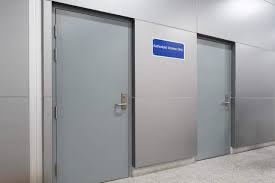Introduction
Fire‑rated steel doors may cost more upfront than standard wooden options, but when viewed over the full lifecycle, they often provide significantly more value. From superior fire safety to lower maintenance and energy savings, these doors are a smart investment for commercial facilities and high-risk environments.
1. Superior Fire Protection & Compliance
Steel doors are inherently non‑combustible. They often achieve up to a 3‑hour fire rating, far exceeding wood doors that typically cap at 90 minutes. This higher rating can reduce insurance premiums and ensure compliance with stringent fire codes like NFPA 80 and UL 10C standards.
2. Unmatched Durability & Security
Constructed from reinforced steel, these doors resist warping, cracking, and forced entry far better than wood :contentReference[oaicite:1]{index=1}. They excel in extreme conditions—resisting blasts, tornadoes, humidity, and moisture—making them ideal for both industrial and high-traffic settings.
3. Minimal Maintenance, Lower Lifecycle Costs
Wood doors need refinishing, termite treatment, and repairs. Steel doors, by contrast, only require occasional cleaning and touch-ups. They resist dents and cracks, and if damage occurs, steel can be repaired or rewelded at a lower cost than replacing a wood door.
4. Energy Efficiency and Thermal Performance
Although steel conducts heat, modern models include foam or honeycomb cores and thermal breaks that result in better insulation than many wood options . Tighter seals and energy-efficient cores can reduce heating/cooling bills and environmental impact.
5. Enhanced Hygiene and Sanitation
In clean environments like hospitals and labs, stainless steel doors are wash-down capable and resist microbial growth. Wood, being porous, absorbs moisture and bacteria and is difficult to sanitize.
6. Adaptable Aesthetics & Customization
Earlier perceptions of steel doors as cold and industrial are outdated. Steel doors now come in painted finishes, wood-grain textures, custom colors, glazing options, and hardware customizations to match any architectural style .
7. Recycling and Environmental Benefits
Steel is highly recyclable, with over 90% recycled content in many doors . In contrast, wood doors may contribute to deforestation and require chemical treatments. Choosing steel aligns with sustainability goals.
Case Study: Lifecycle Cost Comparison
In a commercial building over 20 years, opting for a fire-rated steel door may cost 30% more upfront, but it offers:
- 50% less maintenance cost
- 20% savings on energy bills
- Reduced insurance premiums (~10%) due to higher fire rating
Over time, the steel door saves building owners 10–25% in total lifecycle costs.
Conclusion
While initial investment is higher, fire-rated steel doors deliver long-term savings and benefits through:
- Superior fire resistance and regulatory compliance
- Greater durability and security in harsh environments
- Lowers maintenance and repair expenses
- Improved thermal efficiency and energy savings
- Sanitation capabilities in hygienic settings
- Customizable aesthetics and environmental alignment
For commercial buildings, industrial facilities, and fire-sensitive locations, fire-rated steel doors are a cost-effective, future-proof choice.


